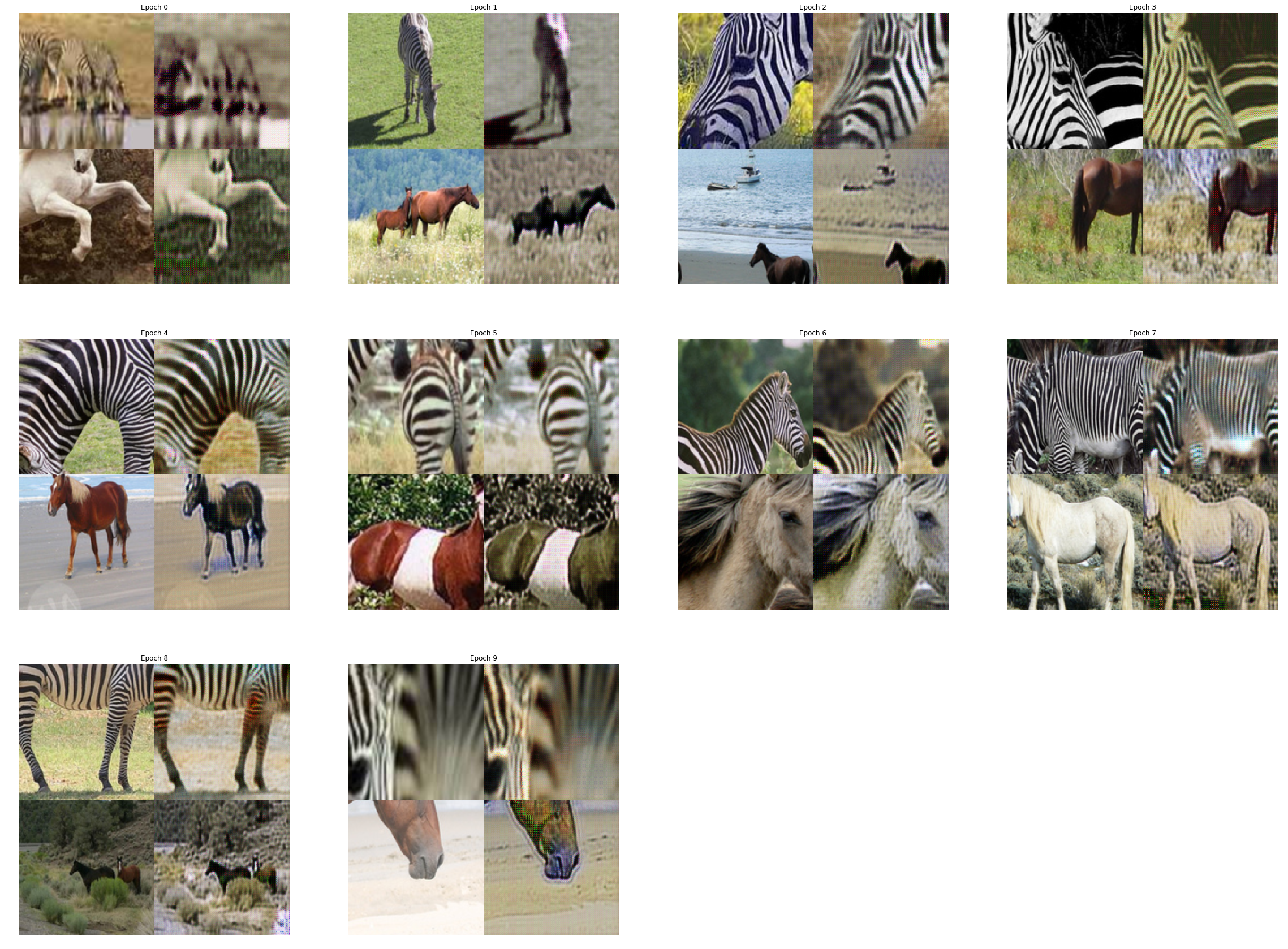set_seed(999, reproducible=True)Metrics for unpaired image-to-image translation
Fréchet Inception Distance
This code is based on this implementation and this implementation, adapted to fastai’s metric API.
InceptionV3
InceptionV3 ()
Base class for all neural network modules.
Your models should also subclass this class.
Modules can also contain other Modules, allowing to nest them in a tree structure. You can assign the submodules as regular attributes::
import torch.nn as nn
import torch.nn.functional as F
class Model(nn.Module):
def __init__(self):
super().__init__()
self.conv1 = nn.Conv2d(1, 20, 5)
self.conv2 = nn.Conv2d(20, 20, 5)
def forward(self, x):
x = F.relu(self.conv1(x))
return F.relu(self.conv2(x))Submodules assigned in this way will be registered, and will have their parameters converted too when you call :meth:to, etc.
.. note:: As per the example above, an __init__() call to the parent class must be made before assignment on the child.
:ivar training: Boolean represents whether this module is in training or evaluation mode. :vartype training: bool
FrechetInceptionDistance
FrechetInceptionDistance (model=None, device='cuda', yb_idx=0, pred_idx=1)
Blueprint for defining a metric
The FrechetInceptionDistance metric works by initializing an Inception model, extracting Inception activation features for each batch of predictions and example images (target), and at the end calculate the statistics and the Frechet distance. Below are test for each of these components.
fid = FrechetInceptionDistance(device='cpu')size = (224, 224, 3)
arrays = [np.zeros(size), np.ones(size) * 0.5, np.ones(size)]*2
img_like_tensor = torch.from_numpy(np.array(arrays)).float()
test_eq(fid.calc_activations_for_batch(img_like_tensor.permute(0,3,1,2),model=fid.model,device='cpu').shape, (img_like_tensor.shape[0],2048))class fake_model(nn.Module):
def __init__(self): super(fake_model, self).__init__()
def forward(self,x): return x.mean(dim=(2,3))
size = (4, 4, 3)
arrays = [np.zeros(size), np.ones(size) * 0.5, np.ones(size)]
input_tensor = torch.from_numpy(np.array(arrays)).float()
stats = fid.calculate_activation_statistics(fid.calc_activations_for_batch(input_tensor.permute(0,3,1,2),model=fake_model()))
test_eq(stats[0], np.ones((3,)) * 0.5)
test_eq(stats[1], np.ones((3, 3)) * 0.25)m1, m2 = np.zeros((2048,)), np.ones((2048,))
sigma = np.eye(2048)
# Given equal covariance, FID is just the squared norm of difference
test_eq(fid.calculate_frechet_distance(m1,sigma,m2,sigma), np.sum((m1 - m2)**2))class FakeLearner():
def __init__(self):
self.yb = [img_like_tensor.permute(0,3,1,2)]
self.pred = [None, img_like_tensor.permute(0,3,1,2)]
learn = FakeLearner()for i in range(5):
fid.accumulate(learn)
print(fid.value)-0.0002026209404561996
CPU times: user 25.9 s, sys: 573 ms, total: 26.5 s
Wall time: 26.4 sQuick Test
horse2zebra = untar_data('https://people.eecs.berkeley.edu/~taesung_park/CycleGAN/datasets/horse2zebra.zip')
folders = horse2zebra.ls().sorted()
trainA_path = folders[2]
trainB_path = folders[3]
testA_path = folders[0]
testB_path = folders[1]
dls = get_dls(trainA_path, trainB_path,num_A=100)
cycle_gan = CycleGAN(3,3,64)
learn = cycle_learner(dls, cycle_gan,metrics=[FrechetInceptionDistance()],show_img_interval=1)learn.fit_flat_lin(5,5,2e-4)| epoch | train_loss | id_loss_A | id_loss_B | gen_loss_A | gen_loss_B | cyc_loss_A | cyc_loss_B | D_A_loss | D_B_loss | frechet_inception_distance | time |
|---|---|---|---|---|---|---|---|---|---|---|---|
| 0 | 10.250998 | 1.617909 | 1.524502 | 0.380783 | 0.408158 | 3.353981 | 3.306977 | 0.414352 | 0.414352 | 90.679044 | 00:48 |
| 1 | 8.985356 | 1.236593 | 1.236445 | 0.291166 | 0.296743 | 2.552362 | 2.653999 | 0.261017 | 0.261017 | 90.476945 | 00:48 |
| 2 | 8.218993 | 1.139003 | 1.041497 | 0.287646 | 0.302079 | 2.395697 | 2.288882 | 0.250520 | 0.250520 | 92.738160 | 00:49 |
| 3 | 7.720056 | 0.971353 | 1.124618 | 0.287192 | 0.313714 | 2.050789 | 2.414080 | 0.249346 | 0.249346 | 93.015558 | 00:49 |
| 4 | 7.342298 | 0.989288 | 0.983895 | 0.300589 | 0.326872 | 2.093399 | 2.157701 | 0.241617 | 0.241617 | 93.109652 | 00:50 |
| 5 | 7.034866 | 1.000397 | 0.922700 | 0.315030 | 0.325621 | 2.095371 | 1.945555 | 0.235398 | 0.235398 | 91.938541 | 00:50 |
| 6 | 6.892154 | 0.982663 | 0.920580 | 0.327344 | 0.346113 | 2.068103 | 2.069340 | 0.227647 | 0.227647 | 91.688272 | 00:50 |
| 7 | 6.704684 | 0.983012 | 0.865727 | 0.347819 | 0.364232 | 1.979038 | 1.902086 | 0.219287 | 0.219287 | 91.998393 | 00:50 |
| 8 | 6.627498 | 0.934832 | 0.936938 | 0.339186 | 0.349980 | 1.971006 | 2.006817 | 0.217617 | 0.217617 | 92.316292 | 00:51 |
| 9 | 6.321739 | 0.864914 | 0.824035 | 0.341803 | 0.348890 | 1.770928 | 1.729100 | 0.211070 | 0.211070 | 91.703895 | 00:52 |
/home/tmabraham/fastai/fastai/callback/core.py:50: UserWarning: You are shadowing an attribute (G_A) that exists in the learner. Use `self.learn.G_A` to avoid this
warn(f"You are shadowing an attribute ({name}) that exists in the learner. Use `self.learn.{name}` to avoid this")
/home/tmabraham/fastai/fastai/callback/core.py:50: UserWarning: You are shadowing an attribute (G_B) that exists in the learner. Use `self.learn.G_B` to avoid this
warn(f"You are shadowing an attribute ({name}) that exists in the learner. Use `self.learn.{name}` to avoid this")
/home/tmabraham/fastai/fastai/callback/core.py:50: UserWarning: You are shadowing an attribute (D_A) that exists in the learner. Use `self.learn.D_A` to avoid this
warn(f"You are shadowing an attribute ({name}) that exists in the learner. Use `self.learn.{name}` to avoid this")
/home/tmabraham/fastai/fastai/callback/core.py:50: UserWarning: You are shadowing an attribute (D_B) that exists in the learner. Use `self.learn.D_B` to avoid this
warn(f"You are shadowing an attribute ({name}) that exists in the learner. Use `self.learn.{name}` to avoid this")
/home/tmabraham/anaconda3/lib/python3.7/site-packages/fastprogress/fastprogress.py:74: UserWarning: Your generator is empty.
warn("Your generator is empty.")